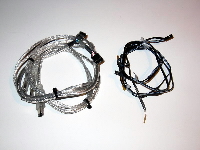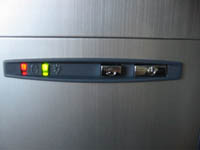There are plenty of 5,25″ mounted monitoring and controlling units available. Everyone have different functions, some are only used for fan controlling, some show two temperatures, others supply extra connection possibilities. Unfortunately you must often settle with just one such product, because they cost money, and sometimes all 5,25″ slots are being used.
There are plenty
of 5,25" mounted monitoring and controlling units available. Everyone
have different functions, some are only used for fan controlling, some show
two temperatures, others supply extra connection possibilities. Unfortunately
you must often settle with just one such product, because they cost money,
and sometimes all 5,25" slots are being used. Probably this was exactly
what the guys at Vantec thought when they designed this accessory. It goes
by the name "Vantec Nexus Multi-Function Panel". It is a panel withtemperature
monitoring, fan controlling, USB and FireWire ports. We shall look a little
bit closer on this peripheral, it seems to be a smart all-round solution.
The package contain
almost everything you need, it comes with a manual, two exchangeable front
bezels (for switching colour), one allen key for exchanging the panels, a
double production of screws for mounting the panels, a FireWire cable, an
USB 2.0 cable, two fan extension cables, three temperature sensors and one
power cable. The power cable is unfortunately not a Y-cable, so you loose
one molex contact while plugging it in.
The USB cable
has two heads, so you can connect two USB units at the front of your case.
The USB and FireWire cables match each other, and are everything but gray
standard cables. There is a kind of silver coloured fabric around the cables
protected by transparent tubing. The end supposed to be connected to the panel
is furthermore protected with a black shrinking tube. The fan cables, which
are intended for connecting the CPU fan to the panel, are regular standard
cables. The thermistors are almost completely flat, making them easy to mount
on the hard drive, graphics card or between the processor and heatsink. They
can measure temperatures between 15 and 70 degrees celsius, which is more
than enough for those not using extreme cooling. The thermistors are connected
to pretty thick cables, this can be a problem since the cable might not fit
between the CPU and heatsink, but will also make the readings more accurate.
Note that all the cables are labeled where they are supposed to be connected,
no risk of confusion here.
You can change
the colour on the front of the panel by detaching the plastic panel, and mount
another one. You can of course make your own, for a more personal look on
the panel. You also get 4 extra screws for those who fritters away such things.
A picture of the accessories can unfortunately not be included in this review.
|
|
|
| Price/Availability |
The price is
around $35, which is a lot. Temperature sensors are available at around $8-$10
and a RheoBus is available for $25-$30, but the LCD-display is in fact very
uncommon on panels like this and you only need one unit when buying this multi-panel.
The availability is quite good, it is available in a few computer hardware
stores.
|
Price/Availability
|
||
|
We compare the price against similar products and also the availability among distributors. |
|
|
This combo 5,25"
unit have almost everything; USB and FireWire ports, RPM controlling for one
fan and temperature monitoring. It would be nice to see a headphone connection
too, but it is a less important detail. The temperature sensors have an update
rate of 2 seconds, which is good enough because of the stable temperatures
of a computer (unless in case of fan failure). One of the sensors is for mounting
on the hard drive, the second one in the case and the third on the processor.
You can of course mount these where ever you want, but I strongly suggest
you don’t mount the CPU sensor on any other place, because when the temperature
exceeds 65 degrees the whole panel starts beeping like if it was obsessed.
The highest temperature i managed to read was 90 degrees, and this was with
almost boiling water, and the lowest was 3 degrees with an ice/water mix.
By the specifications it can measure temperatures between 15 and 70 degrees,
meaning that the temperatures become inaccurate when exceeding those limits.
|
|
|
If the fan is
not spinning fast enough, or is not connected, the panel will beep in the
same way as it does when the CPU temperature exceeds 65 degrees. This is of
course good because you have an automatic supervision of your system, but
I would like to be able to turn it off because you might want to place the
CPU sensor somewhere else than on the CPU, or have a CPU fan with no RPM circuits.
The cables are
long enough for those with midi towers, but if you have a full tower you might
want to place the panel as far down as possible.
|
Functionality |
||
|
We look at how the product meets up to its specifications, and other goals. We also look at eventual side effects. |
|
|
The base itself
is made completely out of aluminium with a coloured plexi plate mounted on
it. The plate can be changed, it comes with one blue and one green plate.
The middle of the panel is decorated with a big knob used for controlling
the fan speed of the connected fan, next to it is a small button which is
used for choosing which thermometer you want to read from. To the right is
the two USB 2.0 ports, and one FireWire port. The LCD display has black digits
and a green background light, which is most common for displays. It would
have been nice to see a blue or red background light, but this is a luxury
few companies enhance their products with. The display is easy to read and
the values are displayed with large numbers.
|
|
|
The functional
design is also very good, everything is labeled on the circuit board or in
the manual. The installation could not have gone easier, and there is no mess
with the cables. It even comes with small notes put on the temperature sensors
so you can differentiate between them. The base itself is a little too short,
and it is quite hard to mount it in a case with drive rails. In either way
it is meant for aluminium cases which rarely have this finesse.
|
|
|
Design
|
||
|
We take a look at how the product is designed, both aesthetically and functionally. |
|
|
I was actually
positively surprised by this product, before I tested it I thought it was
just a nice shell for a not so very promising product, but the panel turned
out to be very good. The best thing is of course all the functions; USB and FireWire
ports, thermal monitoring and fan controlling. The warning signal is also
very good, because it warns automatically if the CPU fan fails or the temperature
gets too high. Unfortunately even the sun has its spots, it is a shame that
you can not turn off the automatic warning sound. The green colour of the
display is not much to cheer for either, but these are just small things.
The one disadvantage worth considering is the difficulty to mount it if you
have drive rails in your case, because the sides are not long enough. To summarize:
it is a suitable product for the home user with a computer who wishes to regulate
the noise of a fan, and keep an eye on the temperatures. An advanced user
usually do not content with only one fan to control, but the temperature monitoring
is very good.
|
Vantec
Nexus Multi-Function Panel  |
|
|
Pros: + Many functions, saves space + 3 thermal sensors + Automatic warning Cons: |
|
| Price/Availability |
8.0
|
| Functionality |
8.5
|
| Design |
9.0
|
Final grade: |
|




























Leave a Reply